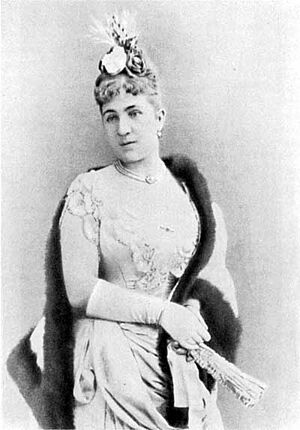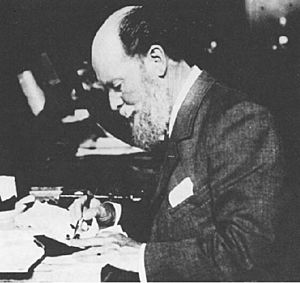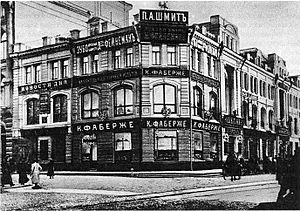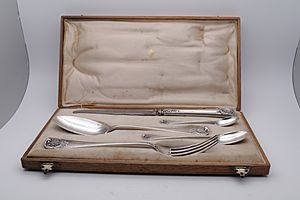Peter Carl Fabergé facts for kids
Quick facts for kids
Peter Carl Fabergé
|
|
|---|---|
| Карл Густавович Фаберже | |
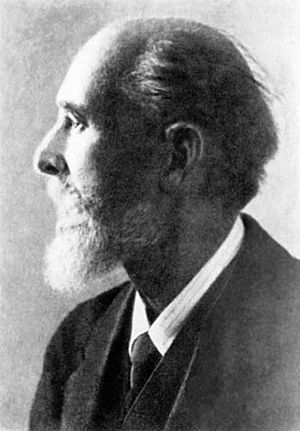 |
|
| Born | 30 May 1846 Saint Petersburg, Russia
|
| Died | 24 September 1920 (aged 74) |
| Nationality | Russian |
| Spouse(s) |
Augusta Julia Jacobs
(m. 1872) |
| Children | 4 (incl. Agathon and Alexander) |
| Parent(s) |
|
Peter Carl Fabergé (born May 30, 1846 – died September 24, 1920) was a famous Russian jeweler. He is best known for creating the amazing Fabergé eggs. These were like real Easter eggs but made from expensive precious metals and sparkling gemstones. Peter Carl was one of the sons who continued the famous jewelry business, the House of Fabergé.
Contents
Early Life and Training
Peter Carl Fabergé was born in Saint Petersburg, Russia. His father, Gustav Fabergé, was a jeweler from a German family. His ancestors were Huguenots who had moved from France to Germany, then to Russia.
Carl went to the German St Anne School in Saint Petersburg until he was 14. In 1860, his father retired and moved to Germany. He left the family business, the House of Fabergé, to his business partner.
Carl then studied at the Dresden Arts and Crafts School in Germany. In 1864, he went on a "Grand Tour" of Europe. He learned from skilled goldsmiths in Germany, France, and England. He also took a course in Paris and visited many museums.
His travels and studies lasted until 1872. At 26, he returned to St. Petersburg and married Augusta Julia Jacobs. They had four sons: Eugene, Agathon, Alexander, and Nicholas. For the next 10 years, Hiskias Pendin, his father's trusted worker, helped guide him. The company also helped to organize and fix items at the Hermitage Museum.
Taking Over the Family Business
In 1882, Hiskias Pendin passed away. Carl Fabergé then took full control of the company. He earned the title "Master Goldsmith," which meant he could use his own special mark on his creations. In 1885, his brother Agathon joined the company. Agathon became Carl's main helper in designing jewelry.
Carl and Agathon Fabergé became very famous at an exhibition in Moscow in 1882. Carl won a gold medal. One of their displayed pieces was a copy of an old gold bracelet from the Hermitage Museum. The Russian ruler, Tsar Alexander III, was amazed. He said he couldn't tell the difference between Fabergé's copy and the original!
The Tsar ordered that Fabergé's work be shown in the Hermitage Museum. This showed how excellent Russian craftsmanship was. The House of Fabergé quickly became very popular with the Russian Imperial Court.
When Peter Carl took over, the company changed its style. They moved from making jewelry in the old French style to becoming true artist-jewelers.
The First Imperial Easter Egg
In 1885, Fabergé made his first famous Fabergé egg, called the Hen Egg. The Tsar gave it as a gift to his wife, Empress Maria Fyodorovna, for Easter. She loved it so much that the Emperor gave Fabergé a special title: "Goldsmith by special appointment to the Imperial Crown."
This special title allowed Fabergé to access the important Hermitage Museum collection. He could study the items there and find new ideas for his unique style. He was inspired by old jeweled flower bouquets and Japanese art. This helped him bring back the lost art of enameling. He also focused on setting every single gemstone to make it look its best.
Agathon often made many wax models for a piece. This ensured they explored all ideas before choosing a final design. The company also started making "objects deluxe." These were gold items decorated with jewels and enamel, like electric bell pushes and cigarette cases.
The Famous Easter Eggs
Because the Empress loved her Easter egg so much, the Tsar ordered one every year. Starting in 1887, Carl Fabergé had complete freedom to design the eggs. They became more and more detailed. The Fabergé family says that even the Tsar didn't know what the eggs would look like. The only rules were that each egg had to be unique and contain a surprise inside.
After Tsar Alexander III died, his son, Tsar Nicholas II, continued the tradition. He ordered two eggs each year: one for his mother and one for his wife, Empress Alexandra. These special Easter eggs are known today as "Imperial Easter eggs." The tradition continued until the October Revolution in 1917. The two final eggs were never delivered.
Even though the Imperial Easter eggs are very famous, the House of Fabergé made many other beautiful items. These included silver tableware and fine jewelry. Before the revolution, Fabergé's company was the largest jewelry business in Russia. It had stores in Saint Petersburg, Moscow, Odessa, Kiev, and London. Between 1882 and 1917, they made about 150,000 to 200,000 items.
In 1900, Fabergé's work was shown at the 1900 World's Fair in Paris. Carl Fabergé was part of the jury, so his company showed its work "hors concours" (without competing). Still, the company won a gold medal. Carl Fabergé was also honored with one of France's highest awards, becoming a knight of the Legion of Honour. This exhibition was a big success, bringing many new orders and customers.

The Russian Revolution and Fabergé's Later Life
In 1916, the House of Fabergé became a joint-stock company. The next year, the October Revolution began. The business was taken over by a committee of employees. In 1918, the Bolsheviks seized the House of Fabergé. All their stock was taken. The House of Fabergé no longer existed.
After his business was taken, Carl Fabergé left St. Petersburg. He traveled to Riga, then to Germany. He settled in Bad Homburg and later in Wiesbaden. His oldest son, Eugène, traveled with his mother through snow-covered woods to Finland. In 1920, Eugène joined his father in Switzerland, where other family members had found safety.
Peter Carl Fabergé never fully recovered from the shock of the Russian Revolution. He died in Switzerland on September 24, 1920. His family believed he died of a broken heart. His wife, Augusta, died in 1925. In 1929, Eugène Fabergé moved his father's ashes to be buried with his mother in Cannes, France.
Fabergé had five sons, four of whom lived to be adults: Eugène, Agathon, Alexander, and Nicholas. Today, descendants of Peter Carl Fabergé live in Europe and South America.
|
See also
 In Spanish: Peter Carl Fabergé para niños
In Spanish: Peter Carl Fabergé para niños


